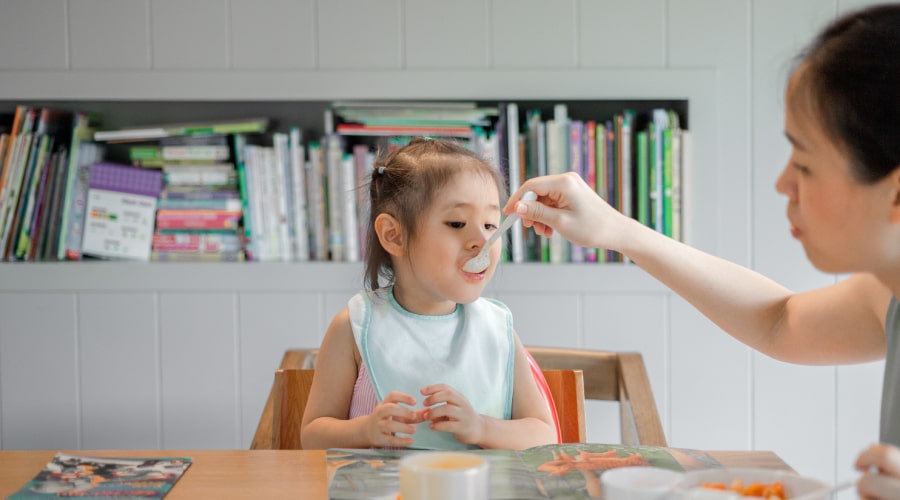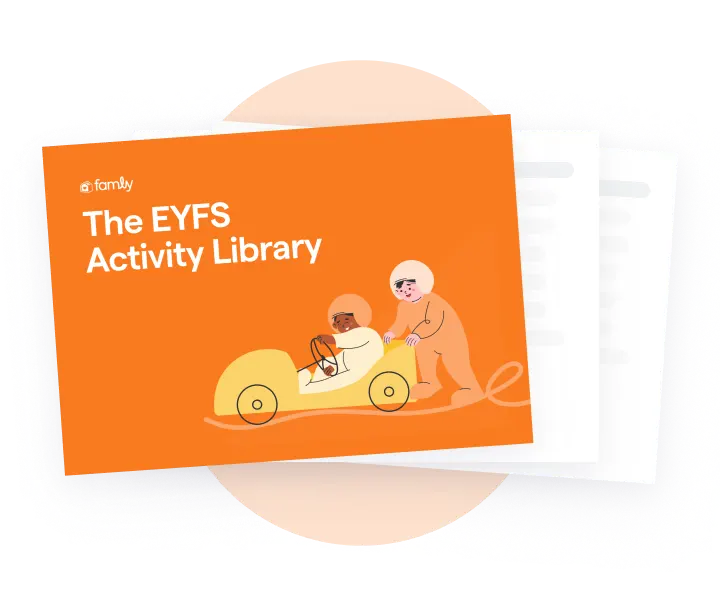settings
children
With Famly since
Mealtimes with toddlers can be stressful. It can be tough to make broccoli seem approachable, and sometimes spaghetti ends up on the kitchen ceiling.
You’ve probably already read something about how we help children develop healthy eating habits, like monitoring what food you have on offer at your setting or involving the parents in your mealtime decisions. But the thing is, those healthy habits might not stick if we don’t talk about food in the right way.
Regardless of whether or not you have a fussy eater on your hands, the way we talk about food to toddlers has a massive impact on their relationship with it. Is encouraging children to eat their full plate before they get dessert encouraging overeating? Are we helping children understand when they’re full? Is labelling sugary foods ‘unhealthy’ and broccoli ‘healthy’ affecting how children associate likes and dislikes?
We’ve got some top tips on key phrases to think twice about, positive language we should be using and why talking about food helps children understand and appreciate what they’re eating.

How children use food as a dialogue
We all have food we’d rather not eat, and food that we really can’t stand. But when toddlers are just beginning to try new foods, it’s not just about trying to find foods that they like and giving them a wide variety of them.
We make food with toddlers and young children an interactive activity, with lots of encouragement, dialogue and negotiation. We ask them if they like the taste of carrots, if they could please try eating those peas they’ve pushed to the side of their plate. Words go hand in hand with eating and enjoying food.
Children are constantly modelling their parents or caregivers, so the words we use to describe food we’re eating is just as important. Joking that you’re cutting out chocolate entirely because it’s going ‘straight to your hips’ may seem lighthearted, but this can affect the emotions and relationship children have with that food.
Though that’s certainly not a bad thing if we just turn it on its head. You interact with the little ones at mealtimes, give them food, snacks and talk to them about food every single day. You play a central role in helping them to build that healthy relationship, just through your dialogue with them in your Early Years environment.
Positive language about food is key
Labelling definitely matters, particularly when it comes to building a positive relationship with food, but so is the way we encourage children to eat.
Before we get to labelling, let’s take a look at some common phrases we might use when we’re trying to nudge toddlers to eat their greens, and why using negative language as a default may be doing more damage than we realise.
- “Come on, I know you can finish your plate for me.”
This seems innocent enough - you’re encouraging a child to eat the food that’s been prepared, and that they need to get lots of lovely energy. But when we say this, we’re making the act of eating a favour to the adult. It’s not about the child listening to their body and when it tells them they’re full, but a request from an adult and a task they need to complete.
This can prevent children from understanding when they’re full and overeat as they grow older, and can make eating a chore rather than an enjoyable activity.
- “You need to eat it up, it’s good for you.”
Of course broccoli is good for us, but this is a negative way of viewing nourishing food. This makes it seem like a task the child needs to complete, and doesn’t explain why eating broccoli is a good idea. There’s no explanation that broccoli has protein or fibre in it, or why protein is so important for growing bodies.
- “No ice cream until you’ve tried your carrots”
We might try and bribe children with dessert as a reward for trying a ‘healthy’ food or finishing their plate. However, the act of withholding food places a lot of pressure on children to eat up, even if they don’t want it. This overrides their own ability to decide if they even want ice cream in the first place.
The perils of labelling food as 'good' or 'bad'
Putting food into one of two categories puts them in a very defined box. It’s either positive or negative. Healthy or unhealthy. Fattening or slimming. Sugary or sugar-free. And who decides what’s healthy and what isn’t? We only need to look at ‘low-fat’ products to realise that sometimes they’re packed with other artificial ingredients, and aren’t exactly the healthier option.
If we’re taking it to the extreme, being overly negative about unhealthy food could cause children to become terrified of it. If you negatively comment on the little chocolate digestive in a child’s packed lunch, is this going to help them learn that we can eat sugar in moderation? What about your offhand comment to your colleague that you’re cutting out pasta, bread and pastries for a month to avoid carbohydrates?
Labelling can lead to children thinking that sugary or ‘unhealthy’ foods are the big bad wolf. This can very easily spiral as children grow older, as we see with eating disorders like orthorexia - an uncontrollable obsession with clean eating.
But what to say instead? One practitioner has stopped referring to foods as either healthy or unhealthy, using the benefits of food like ‘nutrient dense’ or ‘protein-packed’ instead. It turns out that taking a nutrition-based approach works wonders, as foods aren’t being compared but appreciated for the benefits they bring. Trying to drive home the point that carrots are ‘good for you’ doesn’t explain anything at all. Chatting about vitamin A or why they’re good for us makes it that much more likely that they’ll nibble them happily at snack time.
The big ideas

Top tips for food talk
It might seem like there’s a lot to keep in mind. But if we just take it very slowly and start being mindful about the words we’re using when we talk about eating and food to our youngest, we can help children cultivate wonderful relationships with food.
Here are a few tips to get you started:
- Try to avoid labelling food as ‘healthy’ or ‘unhealthy’. Why not describe the benefits of the food instead, like ‘this will help you build strong muscles’ or describe why they can’t have too much of it with ‘this will make you overexcited and sleepy’. Helping children understand the food in front of them goes a long way.
- Take the pressure off. A relaxing environment is key to help children enjoy their mealtimes, and negative emotions can actually suppress appetite and make food less desirable. Getting cross with them for not eating their vegetables might put the pressure on, and have the complete opposite effect.
- Help children understand that when they’re full, they don’t need to continue eating. Using phrases like ‘Do it for me, please’ or ‘I know you can eat the last little bite’ overrides children’s natural ability to stop when their tummies are full, and makes eating food a search for approval from an adult. Instead, try asking if they’ve had enough or if they’re full.
- Use positive or neutral words whenever possible. If adults are more positive about the food on a child’s plate, they’re much more likely to react positively to it.
If you’d like to read a bit about tackling fussy eaters, have a look at our article on why children reject food and what you can do about it. Or if you’re looking to create the perfect mealtime environment, have a look at our piece here.
Try learning journals for free
Add observations, and build digital learning journals to share with families instantly. All with your completely free 14-day trial.
Get started









